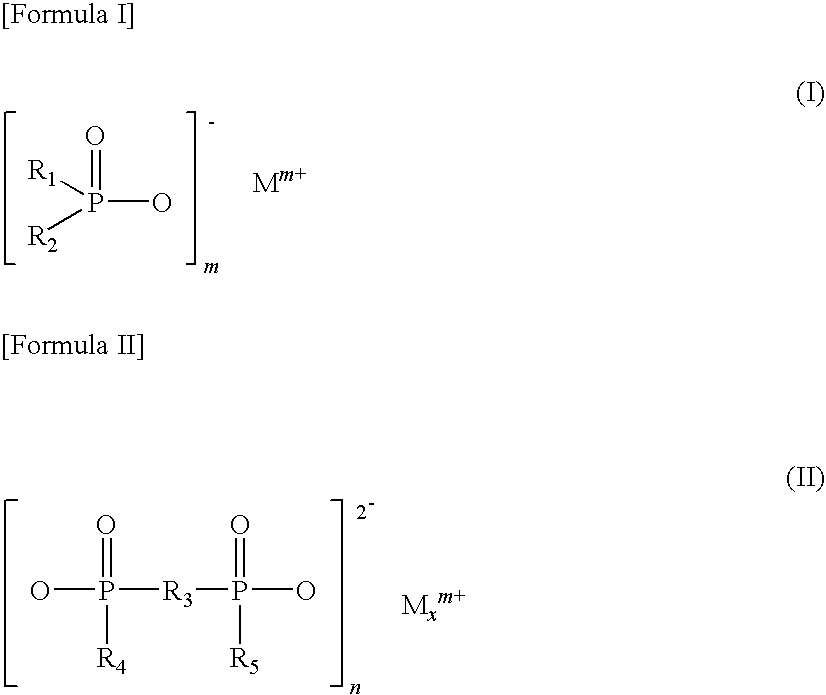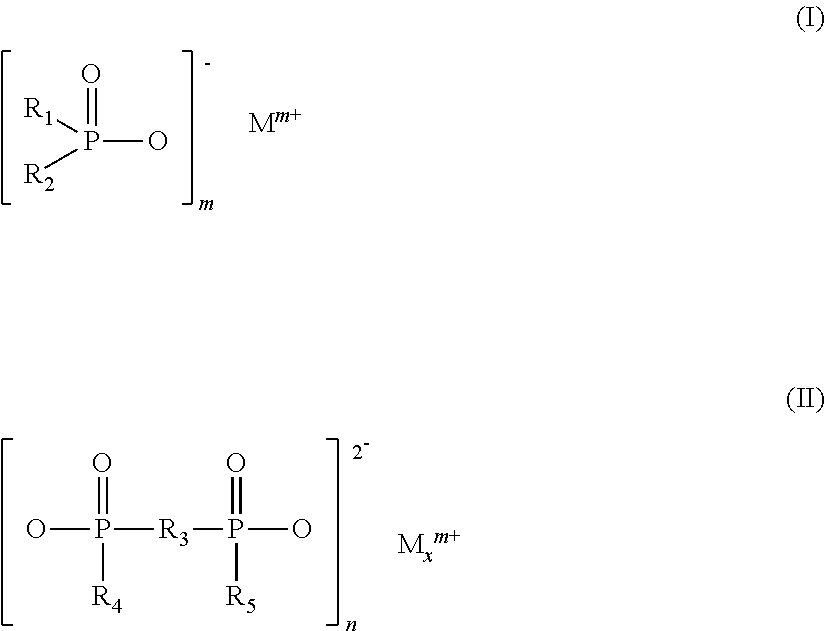Flame-retardant glass fiber-reinforced polyamide resin composition
a glass fiber and resin technology, applied in the field of resin compositions, can solve the problems of adverse effects on the environment and human, restriction of the use of halogen-based flame retardants, and halogen-based flame retardants, and achieve the effects of high flame retardancy, superior surface smoothness and appearance, and high rigidity
- Summary
- Abstract
- Description
- Claims
- Application Information
AI Technical Summary
Benefits of technology
Problems solved by technology
Method used
Image
Examples
examples
[0062]Hereinafter, the present invention will be described more specifically with reference to Examples. The materials and the evaluation methods used in Examples and Comparative Examples are as follows:
[0063](1) Materials Used
(A) Polyamide Resin
(a1) Crystalline Polyamide Resin
[0064]Crystalline polyamide resin (a1-1): polyamide 66 (24AD1, product of Rhodia) (melting point: 265° C., relative viscosity: 2.4, heat of fusion: 21 cal / g)
[0065]Crystalline polyamide resin (a1-2): polyamide 6 (A1015, product of UNITIKA. LTD (melting point: 220° C., relative viscosity: 2.0, heat of fusion: 18 cal / g)
(a2) Amorphous Polyamide Resin
[0066]Amorphous polyamide resin (a2-1): polycondensate of isophthalic acid / terephthalic acid / hexamethylenediamine / bis(3-methyl-4-aminocyclohexyl)methane (CX-3000, product of UNITIKA. LTD) (glass transition temperature: 125° C., relative viscosity: 1.9, heat of fusion: 0.1 cal / g)
[0067]Amorphous polyamide resin (a2-2): polycondensate of isophthalic acid / terephthalic acid...
example i-1
[0097]One hundred parts by mass of a flame-retardant polyamide resin composition containing 51.8 percent by mass of a crystalline polyamide resin (a1-1), 22.2 percent by mass of an amorphous polyamide (a2-1) and 26.0 percent by mass of a flame retardant (B-1) were blended with 100 parts by mass of a glass fiber (C-1) in a biaxial extruder (TEM37, manufactured by Toshiba Machine Co., Ltd) under the conditions of a cylinder temperature set to 280° C., a screw rotation of 200 rpm and a discharge rate of 35 kg / h, while the components other than the glass fiber were fed from the main inlet and the glass fiber from the side inlet, and the blend was kneaded and extruded into strands, which were granulated with a cutter after cooling to give pellets of the polyamide resin composition. The properties of the pellet obtained were evaluated by the measuring methods described above. The results are summarized in Table 2.
examples i-2 to i-16
[0098]Pellets were prepared in a manner similar to Example I-1, except that the blending ratio of the components was changed as shown in Table 2 and the cylinder temperature of the biaxial extruder in Example I-5 was changed to 260° C., and the various properties thereof were determined. The results are summarized in Tables 2 and 3.
[0099]
TABLE 2ExampleI-1I-2I-3I-4I-5I-6I-7I-8Blending ratePolyamide resin / flame retardant100.0100.0100.0100.0100.0100.0100.0100.0(parts by mass)Resin compositionCrystalline polyamidea1-151.838.564.866.651.851.851.8(percent by mass)resin (a1)a1-258.4Amorphous polyamidea2-122.238.57.414.622.222.222.2resin (a2)a2-27.2Flame retardant (B)B-126.023.028.026.027.026.026.026.0B-2B-3Glass fiber (C)C-110010010010070200100C-2100Silicone oil (E)E-10.2(a2) / (a1) + (a2)0.30.50.10.10.20.30.30.3(B-2) / (B)0.000.000.000.000.000.000.000.00PropertiesRunning properties◯◯◯◯◯◯◯◯Blending strengthMPa270265260260250250330270Blending modulusGPa16.51615.51615.5132116.5Flame retardanceV-...
PUM
| Property | Measurement | Unit |
|---|---|---|
| aspect ratio | aaaaa | aaaaa |
| melting point | aaaaa | aaaaa |
| heat resistance | aaaaa | aaaaa |
Abstract
Description
Claims
Application Information
 Login to View More
Login to View More - R&D
- Intellectual Property
- Life Sciences
- Materials
- Tech Scout
- Unparalleled Data Quality
- Higher Quality Content
- 60% Fewer Hallucinations
Browse by: Latest US Patents, China's latest patents, Technical Efficacy Thesaurus, Application Domain, Technology Topic, Popular Technical Reports.
© 2025 PatSnap. All rights reserved.Legal|Privacy policy|Modern Slavery Act Transparency Statement|Sitemap|About US| Contact US: help@patsnap.com


